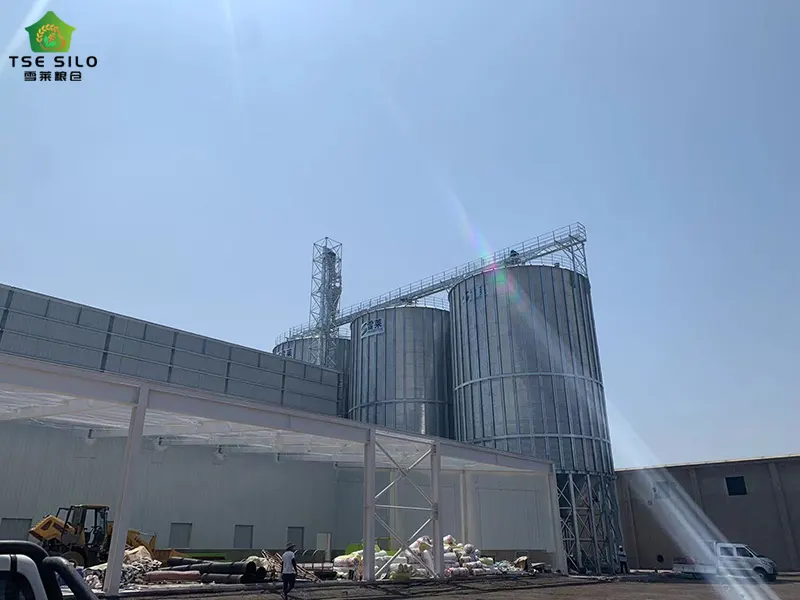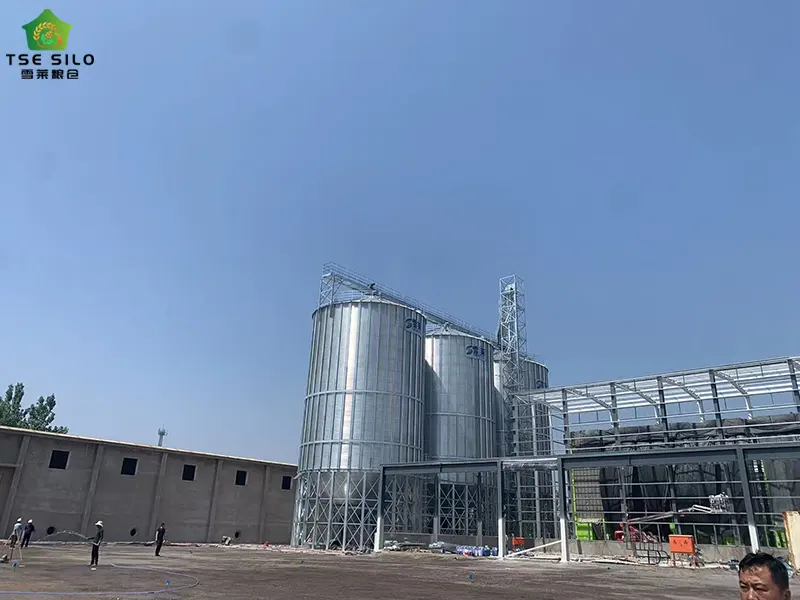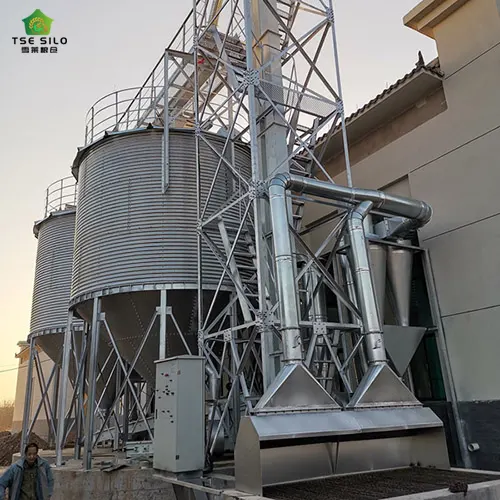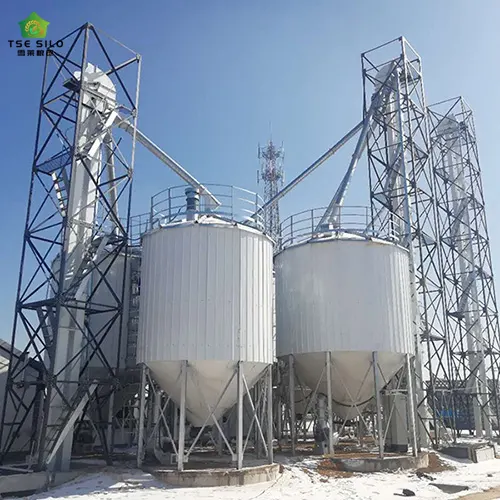let's consider staffing.
Managing a large steel silo requires considering numerous factors, both in terms of silo capacity and the materials stored. The following are some specific considerations.
- 1. Scale and complexity of the silo: Is it a single silo or a cluster? What is the total capacity?
- 2. Nature of the stored materials: Grain, cement, fly ash, mineral powder, chemical raw materials, etc.? Different materials have varying operational, safety, and environmental requirements.
- 3. Degree of automation of the loading and unloading process: Is it highly automated or does it require significant manual intervention?
- 4. Ancillary equipment: The complexity of the conveying system (pneumatic, mechanical), dust removal system, metering equipment, temperature measurement/ventilation/fumigation systems, and silo cleaning equipment.
- 5. Operational mode: Is it continuous loading and unloading (such as in cement plants and port transshipment) or batch loading and unloading (such as seasonal grain storage)?
- 6. Safety Management Requirements: Especially for high-risk areas such as dust explosion prevention, working in confined spaces, and working at height.
- 7. Geographic Location and Management Model: Is remote monitoring required? Is independent security required?


Core Staffing Framework for Operations
The following is a typical core staffing framework for operating a large steel silo (especially for bulk materials such as grain, cement, and fly ash). You can adjust it based on the above factors:
I. Core Management and Technical Positions (Usually Daytime Shift)
1. Warehouse Manager/Supervisor:
- Responsibilities: Overall responsibility for the operation, safety, personnel management, cost control, coordination with upstream and downstream partners, inventory management, and planning of the steel silo area.
- Staffing: Typically one person (large and complex silo clusters may require a deputy or division by area).
2. Equipment Engineer/Technical Supervisor (Mechanical/Electrical):
- Responsibilities: Responsible for developing maintenance plans, troubleshooting and repairing, technical upgrades, and spare parts management for all steel silos, infeed and outfeed conveying equipment (elevators, belt conveyors, screw conveyors, air compressors, fans, etc.), dust removal systems, metering equipment, and automated control systems. Ensure equipment reliability.
- Staffing: Depending on the complexity of the equipment, one mechanical engineer and one electrical/automatic control engineer may be required. Smaller or highly automated facilities may be managed by a general engineer.
3. Safety Manager/Specialist:
- Responsibilities: Responsible for compliance with safety regulations in the steel silo area, safety training (especially regarding dust explosion prevention, confined spaces, working at height, and fire prevention), safety inspections and hazard detection, emergency plan development and drills, accident investigation and response, and management of labor protection supplies.
- Staffing: At least one full-time or part-time staff member (depending on the scale and risk level). Safety responsibilities are the shared responsibility of all personnel.
4. Quality Control/Inspector (if applicable, especially for grain and food raw materials):
- Responsibilities: Responsible for quality inspection of incoming materials, quality monitoring of in-warehouse materials (temperature, humidity, pests, mildew, etc.), quality verification of outgoing materials, and related record keeping.
- Staffing: One or more personnel assigned based on the frequency and rigor of inspections.
5. Planner/Scheduler (if frequent material inflow and outflow):
- Responsibilities: Coordinate inflow and outflow planning, vehicle scheduling, inventory statistics and reporting, and communication with production/purchasing/sales departments.
- Staffing: One person (may be concurrently or dedicated to the warehouse manager).
II. Operations Position (usually requires shift work to ensure 24-hour coverage)
6. Central Control Room Operator:
- Responsibilities: Monitor the operating status of the entire steel silo area (material level, temperature, pressure, equipment operating status, alarm information) via the DCS/PLC system in the central control room, execute inflow and outflow operation instructions, record operational data, handle general alarms, and communicate and coordinate with on-site personnel.
- Staffing: Staffed on a shift basis. Each shift typically requires 1-2 people (depending on the complexity of the system and the number of monitoring points). For example, a four-shift, three-way operation would require 4-8 people.
7. On-site Inspection/Operator:
- Responsibilities:
- Conduct on-site equipment inspections (listening, observing, touching, and measuring) according to the route, record operating parameters, and promptly report any abnormalities.
- Perform simple on-site operations (such as manual valve switching, assisting with equipment startup and shutdown, and sampling).
- Assist maintenance personnel with equipment maintenance.
- Responsible for sanitation and cleanliness of assigned areas (especially dust removal).
- Enforce safety procedures, such as pre-entry inspections and monitoring of confined spaces.
- Staffing: Staffing is based on shifts. The number of people per shift depends on the size of the warehouse complex, equipment distribution, and the degree of automation. It may range from one to several people per shift. For example, a medium-sized warehouse complex may require 2-3 on-site workers per shift. A four-shift, three-way operation would require 8-12 people.
III. Maintenance and Support Positions (Usually Daytime Shift, or with On-Duty Personnel)
8. Maintenance Technician (Mechanical/Electrical/Instrumentation):
- Responsibilities: Under the guidance of the equipment engineer, perform routine equipment maintenance, preventive repairs, emergency repairs, spare parts replacement, and other tasks. Responsibilities and certifications are required.
- Staffing: Staffing varies depending on the number of equipment, complexity, and maintenance workload. Several mechanics, electricians, and instrumentation technicians may be required. For example, a medium-sized warehouse cluster may require 3-5 maintenance technicians (including those with different trades).
9. Cleanout Personnel/Outsourced Service (Non-resident, On-demand):
- Responsibilities: Perform professional cleanout operations when materials are compacted, attached to the walls, or require thorough cleaning. This is a high-risk operation requiring specialized personnel and equipment.
- Staffing: Typically, full-time personnel are not assigned; instead, qualified, professional cleanout companies are hired as needed.
IV. Key Considerations and Staffing Flexibility
- Degree of Automation: This is the most critical factor affecting staffing requirements. Highly automated systems (such as fully automatic feeding and discharging, online monitoring, and intelligent ventilation) can significantly reduce the number of on-site inspections and operators, but they place higher technical requirements on central control operators and maintenance personnel.
- "Multi-skill" and job rotation: Encouraging employees to master multiple skills (e.g., central control operators possessing basic field knowledge, while field workers can troubleshoot simple problems) can improve staff utilization efficiency and the ability to respond to emergencies.
- Outsourcing: Consider outsourcing certain tasks, such as professional equipment overhauls, warehouse clearance services, security, and cleaning of selected areas, to reduce permanent staffing.
- Training: All personnel, especially on-site operators and maintenance personnel, must receive rigorous safety training (in dust explosion prevention, confined spaces, working at heights, and emergency rescue) and job skills training.
- Regulatory requirements: Local regulations requiring certification for specialized workers (electricians, welders, crane operators, and those working in confined spaces, etc.) must be followed. Safety managers may require specific qualifications. Scale effect: For a warehouse cluster consisting of multiple steel silos, certain management positions (such as managers, engineers, and safety officers) can cover a larger area and achieve higher per capita efficiency.


Summary of staffing configuration examples
The following is a configuration example for a medium-sized, medium-automated bulk grain steel silo cluster, for your reference only.
- Management and technical positions (regular day shift): Warehouse manager (1), equipment engineer (1-2), safety manager (1), quality inspector (1-2), planner (1) - a total of about 5-7 people
- Operation and operation positions (shift, four shifts and three operations):
- Central control operator: 1 person per shift, 4 shifts = 4 people
- On-site inspection/operator: 2 people per shift, 4 shifts = 8 people
- Maintenance and support positions (regular day shift): Maintenance technicians (mechanical/electrical/instrumentation) 3-4 people
- Total full-time staff: about 20 - 23 people (excluding outsourced clearance services, etc.)
Important note: The above is only a general framework and example. The actual configuration must be precisely calculated and determined based on the detailed design, process flow, automation level, safety risk assessment report, and local regulations for the specific project. Detailed human resource planning is necessary during the project design phase. Safety is always the primary consideration in staffing.
Written by
Shandong Shelley Grain Steel Silo Co., Ltd
Editor Jin
www.grainstoragesilos.com
WhatsApp : +86-18653877118
Email : shelley@cnshelley.com






